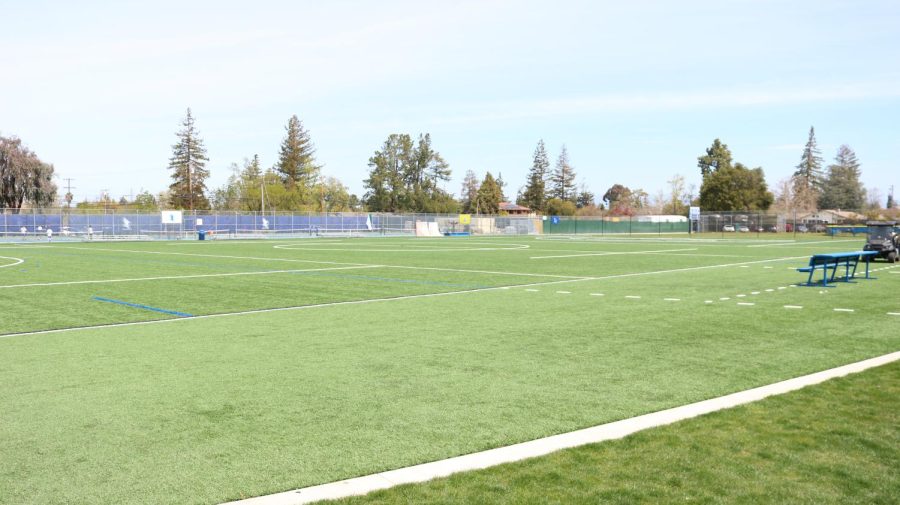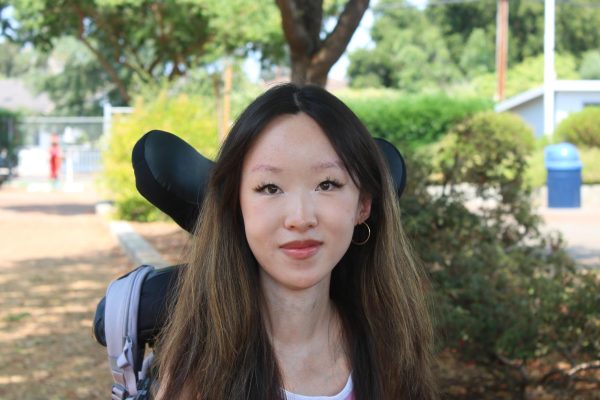LAHS turf fields pose health and safety concerns
One of the two turf fields at LAHS. Turf fields like these have gained increased scrutiny for potential safety concerns, but it’s unlikely that they’ll be replaced.
On its fields, Los Altos High School uses artificial turf — a popular alternative to natural grass for its water conservation and lower maintenance costs, for its football and soccer fields. However, there are growing concerns about turf among health organizations and public school districts due to the potential health risks.
Crumb rubber — small pellets of rubber recycled from tires, a common infill material for turf — is used in both fields at LAHS. Many have reservations about the material’s safety.
Studies by the National Institutes of Health and the European Chemicals Agency have found that 197 chemicals in crumb rubber have been classified as possible carcinogens, and five as known carcinogens. Due to these concerns, policies have still been implemented across the country limiting its use — in Boston, Mass., for example, all artificial turf installations have been blocked.
“I’m not fond of the crumb rubber,” Field Hockey Coach Mary Donahue said. “I can understand why a goalie, who has to dive into the turf and gets pellets everywhere, could be concerned about what it’s made of.”
Sophomore Tyra Bogan, the goalie for the varsity girls soccer team, prefers playing on natural grass the most. Turf causes inconveniences, such as tire pellets getting into her mouth and on her gloves, making it more difficult to catch the ball.
Beyond toxins, the debate over natural and artificial grass also concerns playing conditions, with conflicting findings. A study by the British Journal for Sports Medicine on soccer teams playing on grass versus on artificial turf found no difference in injuries. However, a study by The American Journal of Sports Medicine found that artificial turf yielded 10 percent more injuries overall (but a lesser risk of severe knee and head injuries). In addition, the Center for Climate Systems at Columbia University reported that artificial turf can get up to 60 percent hotter than grass, posing a risk of skin injuries and heatstroke.
Tyra often gets turf burns: scratches on her hips or legs as a result of diving into the rough material. She notices a high injury rate playing soccer on turf. “I have six teammates, and all six have torn their ACL playing on turf.”
Donahue said heat occasionally affects scheduling.
“Field hockey plays all seasons,” Donahue said. “It’s hot. The turf makes it at least 10 degrees hotter.”
However, Athletic Director Michelle Noeth noted that the coaches can accommodate changes in heat by measures like frequent water breaks on hotter days. She added that artificial turf allows games to happen, rain or shine.
“I am very grateful to have the two fields that we have. Any less would make juggling practice times even more challenging,” Donahue said.
Any changes to the fields, according to Assistant Principal Galen Rosenberg, would have to be approved and funded by the district. MVLA Associate Superintendent Mike Mathiesen said changes to the newest fields — installed a year ago — are not likely.
Donahue recalls that she’s played on turf made of coconut husk — an alternative to crumb rubber infill, which is gaining popularity in several school districts across the country.
“Coconut husk turf is far more pleasant,” Donahue said. “It’s cleaner, smells better, and it’s cooler.”
Coconut infill (as well as cork, another alternative) is free of crumb rubber and its carcinogens. However, they have not been guaranteed to be safer, and have safety concerns of their own. “Corkonut” infill often contains large amounts of sand or silica dust, which are a potential hazard for pulmonary health. These organic turfs would also need to be “topped off” – dressed with a new layer of infill – every three to four years due to decomposition, whereas crumb rubber only requires topping off every eight years.
Ultimately, while concerns about crumb rubber are pervasive (if only partially substantiated), it would be an uphill battle to replace the current turf fields at LAHS.





